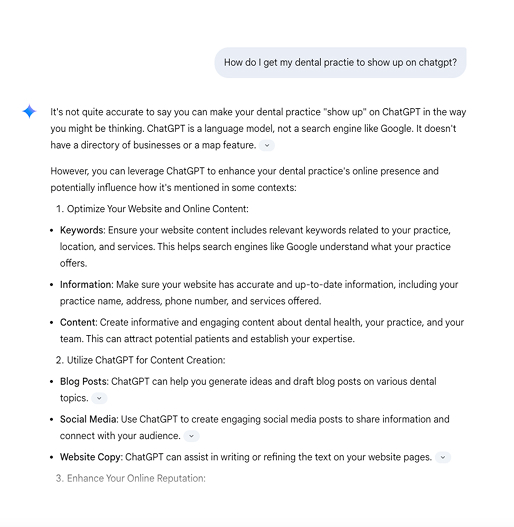Geo-tagging photos on your Google Business Profile (GBP) doesn’t magically boost your rank. Sorry!
What is SEO?
Exploring The Art & Science of Showing Up Online
You’d be forgiven for thinking there’s some grand conspiracy behind search engines—an unseen force deciding which businesses thrive online and which vanish without a trace.
The truth isn’t nearly as exciting (unless you’re like me and get a kick out of this stuff). Appearing in Google results doesn’t require a tinfoil hat, but it does call for more than luck. Yes, social media can spark conversations or fling your brand into viral orbit, but most people who end up on your website via search aren’t there to casually browse cat memes. They’re looking for a direct answer, now.
Enter SEO (Search Engine Optimization): the often misunderstood, occasionally maligned practice of making your site easy to find in the vast cosmos of the internet. If someone tells you “it’s about ranking #1,” be cautious. Ranking #1 for random, meaningless keywords can be as pointless as shouting into an empty room.
And even when you are ranking for a relevant keyword, an SEO’s (Search Engine Optimizer’s) job most certainly isn’t over. This article will show you why that’s the case, how SEO actually works, and what you can do to effectively and ethically land in front of people who are actively searching for your services.
What Is SEO, Really?
SEO. Three letters that somehow became shrouded in mystique. When you boil it down, though, it’s about one thing: helping users find you—without paying for every single click. It’s the difference between renting a billboard on the busiest highway (paid ads) and having a storefront in a bustling neighborhood (organic traffic).
But let’s be real: Where you show up does matter. No one wants to linger on page six of the search results. Still, the primary goal isn’t to boast “I’m #1 for a single obscure term!” The real victory is attracting qualified visitors—those who might actually click that “Book Appointment” button, buy your product, or sign up for your newsletter. Everything else is vanity metrics.
Counting the cost:
An ROI Thought Experiment
Let’s do a quick thought experiment. Suppose you run a dental practice, and you decide to purchase 1,000 clicks on the keyword “dental check up.” Each click goes for $7.36, bringing your total ad spend to $7,360. Not cheap.
Now imagine your business ranking in the organic results for that same phrase. Those 1,000 visitors cost you exactly $0 in ad fees (granted, you’ve invested time, or maybe you’re paying an SEO specialist, but you’re not getting charged per click.)
If just 10% of those visitors come in for a check-up, you’re looking at several thousand dollars of revenue that goes straight to your bottom line.
Money doesn’t grow on trees, but a well-orchestrated SEO strategy can feel like the next best thing.

the Algorithms:
A Peek Behind the Curtain
Google may feel like a single, all-knowing overlord, but in reality, it’s a network of algorithms each doing a specialized job. Let’s distill them into five broad categories:
Discovery
Think of it as Google’s explorer, constantly on the hunt for newly published or updated pages. When something fresh appears online, this mechanism says, “Ah, new land to chart.”
index
This is the gatekeeper. It decides if your page is worthy to be served up in search results at all. If it’s redundant, spammy, or inaccurate, Google might show it to fewer searchers—or bury it so far down you’ll need a virtual shovel to find it.
local
Google’s local tour guide, crucial if you run a physical business—like, say, a family dental clinic.
- Proximity matters
(“Is this business near me?”) - Relevance matters
(“Does this clinic actually offer root canals?”) - Prominence matters
(“Are they legit? Do they have quality reviews?”).
crawl
Once Google knows a page exists, its bots dip a proverbial toe in, scanning your content to figure out what’s going on. Consider it a casual once-over before making a decision about the page’s fate.
rank
The rockstar we hear the most about. It’s the sorting hat that places your page in a hierarchy among billions of competing pages all vying to rank for often just one query. If your content is truly relevant, trustworthy, and engaging, you might emerge near the top.

common misconceptions:
local seo
let’s do ourselves a favor: Provide Google and people the substance they crave. Genuine info, real reviews, and a brand story that resonates. Skipping the cheap gimmicks is the easier path in the long haul.
Keyword stuffing your GBP’s description and services does more harm than good.
Posting on GBP daily doesn’t necessarily nudge your rankings upward. It might help engagement—but that’s different from search placement.
Listing ‘service areas’ when you’re really a storefront? Not exactly a winning strategy.
key components of seo
If the algorithms form the brain of search, these components are the daily habits that keep that brain healthy and humming:
Technical SEO
(In-page)
This is the behind-the-scenes housekeeping: site speed, mobile responsiveness, clean code, and logical site architecture. It ensures Google can find you and that users don’t leave frustrated. A lightning-fast site is like offering visitors a comfy chair the moment they walk into your practice. A slow site feels like waiting too long to be seated at a restaurant.
Off-Page SEO
- Backlinks from credible and industry-relevant websites: Picture them as endorsements saying, “Yes, this site is the real deal.”
- Reviews & Social Proof: Positive chatter on Google Reviews, Yelp, or local forums. (Dental patients might rely on Healthgrades or WebMD, too.
- Citations:
Make sure your Name-Address-Phone (NAP) is consistent so Google isn’t confused by your location or contact info.
On-Page SEO
Here’s where you craft your message—everything from headings to meta descriptions, plus that intangible element called quality content. Done well, on-page SEO tells Google (and readers) exactly what your page delivers. Think of it as your elevator pitch, except you’re pitching to a machine and real humans.
When you weave all these together, you create an ecosystem that signals reliability and relevance.

The Role of SEO in Marketing
Picture your brand as a rocket and each marketing channel—SEO, social media, paid ads, email, even that monthly snail-mail flyer your grandma still loves—as the rocket boosters. SEO is a powerful booster, but it’s not the only one that matters.
Consumers might meet your brand via an offhand remark from a friend, an Instagram reel about your “Top 10 teeth whitening tips,” or a well-placed YouTube ad. Then, they’ll check your website or look up your reviews to see if you’re legit before taking the next step. SEO shapes that crucial “What do other people say about them?” or “Can I find them easily?” moment.
SEO as a Brand-Building Tool
If you build a brand identity (beyond “Best Dentist in [City]”), you give people something to remember. SEO can bolster your brand voice and help improve the number of people who see and engage with your brand organically online.
Organic Visibility vs. Paid Advertising
paid ads
Great if you have a budget for immediate results. Stop paying, though, and it’s lights out.
Organic Search
Takes longer to cultivate. But once established, it’s a bit like having your own apple tree. It delivers returns every year with just a bit of care.
Key Performance Indicators
Some folks obsess over ranking #1 for a certain phrase, only to discover that phrase doesn’t bring qualified leads. As such, rankings as a KPI have been falling out of fashion as of late, one thought leader going so far as to write an official eulogy called “Death of the keyword.”
A better approach? Look at metrics that show real traction:
Organic Traffic
Are people noticing and visiting your site?
Lead Inquiries & Calls
Are those visitors causing your phone to ring?
Appointment Bookings
If you’re a dental office, are people actually scheduling visits?
Vanity metrics are just that—vanity. Keyword rankings and impressions are good steps towards measuring your ability to generate traffic, but if all you get out of your SEO efforts is a lot of visibility but no engagement, it means there’s still work to be done.
Local vs. Standard Search Optimization
Local Search
Think “dentist near me” or “hardware store open now.” The user wants immediate solutions within driving distance. Local search hinges on consistency—making sure your address, phone number, and reviews are accurate across the web. If you get that right, plus nurture a few strong local backlinks and fresh user reviews, you’ll show up for the folks right around the corner.
Standard Search
This is a different beast. Broader queries like “how to fix a leaking sink” can draw thousands from all over the country (or planet). Earning trust here often involves in-depth content, authoritative backlinks, and a brand that consistently delivers. You might not see a direct appointment from that blog post on “Kids’ Braces 101,” but you could become the go-to resource, which eventually leads to referrals, brand mentions, and improved search presence.
AI’s Emerging Role in SEO
Let’s address the ChatGPT-sized elephant in the room. With AI chatbots cranking out content faster than you can say “algorithmic impetus,” is SEO going to go extinct?
Short Answer: Nope
SEO is evolving, as it always does. AI being involved isn’t really new, either.
Back in 2015, Google rolled out a deep learning system called RankBrain which helped it take that next big step in generating more helpful answers to search queries. 10 years later, popular large-language-models (LLMs) like ChatGPT and Gemini come to mind whenever AI is brought up.
It also depends on how the “AI Wars” shape out. These systems are incredibly new. They change all the time, and new models are being released left and right as competition continues to heat up in this space.
Before jumping on the bandwagon of optimizing your website for AI Search, remember that these systems have goals similar to those of traditional SEO. They’re trying to give users accurate and helpful answers so that those users will continue to use those systems. Google, which has been optimizing towards that goal for roughly 25 years, has a robust set of ranking factors already in place.
How can you get your brand to show up in AI search?
For this question I have to provide my favorite answer:
it depends.
It depends on the system you’re using, since ChatGPT doesn’t work the same way that Claude or Perplexity works. Even if you use Gemini and AI Overview, both of which belong to Google, you’ll still get different results.
It also depends on how the “AI Wars” shape out. These systems are incredibly new. They change all the time, and new models are being released left and right as competition continues to heat up in this space.
Before jumping on the bandwagon of optimizing your website for AI Search, remember that these systems have goals similar to those of traditional SEO. They’re trying to give users accurate and helpful answers so that those users will continue to use those systems. Google, which has been optimizing towards that goal for roughly 25 years, has a robust set of ranking factors already in place.

Will AI flood the internet with spam content?
It’s easy to worry that the rise of AI-generated text will bury humanity in a tidal wave of robotic, bland, cookie-cutter content read less by people and more by bots and crawlers alike—like we’ll open Google one day and see a thousand near-identical paragraphs on “the best ways to boil an egg.” The funny thing is: we’ve already been living with spam.
Remember when people still used Internet Explorer? The early days. The good old years where we navigated endless pop-ups that spawned more pop-ups, shady downloads that might give you what you want or might give you a virus—it was the Wild West, and I wonder if people thought the internet was out of control back then.
Despite that chaotic (and fun) mess, we figured it out. Pop-up blockers became a thing. We got better browsers like Chrome, and checks and balances were created to help filter out the junk content.
Spammy “keyword soup” articles have been around far longer than ChatGPT or any other LLM. Before AI, there were (and still are) actual people paid to churn out low-quality, repetitive content by the boatload. So, while the prospect of “AI sludge” might sound terrifying, it’s really just the next chapter in a story we’ve been reading for years. Think about what I mentioned earlier about how billions of pages could appear for even a single query. How many of those billions of pages make it past Google’s ranking “filters” on a day-to-day basis when you search?
Because of constant improvements to search, quality resources still rise to the top more often than not. If your brand focuses on publishing thoughtful, original material—whether you use an AI writer or a human wordsmith—search engines (and people!) will notice.
Just as we overcame the chaos of pop-up nightmares, we’ll adapt to this new era. The key is to see AI as a helpful co-pilot, not your entire creative flight crew. Once you start mass-producing soulless fluff, you’re reenacting the spam-days-of-old, with shinier software.
From Big Picture to Daily Action
We’ve covered the big ideas—why SEO matters, how algorithms size up your site, and why flooding the web with “AI sludge” isn’t the answer.
Now it’s time to zoom in on the nuts and bolts. The following actions aren’t rocket science, but when you do them right, they lay the groundwork for a sustainable, high-quality search presence that outlasts any spam panic or algorithm shake-up
Optimize Your Gbp
Ensure your name, address, and phone (NAP) are accurate on your Google Business Profile. Ask happy customers for reviews–just don't bribe them with free pizza. Authenticity is key.
Go Mobile-First
If your site isn’t mobile-friendly, you’re losing potential patients or customers. People check websites in line at the grocery store, not always at a desk.
Monitor, Rinse, Repeat
Track local keyword rankings, organic traffic, inbound calls, and appointment requests. If a certain page flops, don’t panic—test a new angle or update it with better info. SEO is not a “set it and forget it” initiative.
Create High-Value Content
Answer burning questions. Share stories. Make it impossible for visitors to leave without feeling they learned something real.
Leverage Local Citations & Directories
Same data, same brand name, repeated across credible directories. Inconsistencies can make Google’s head spin.
Looking ahead
Yes, SEO in 2025 is more layered and complex than a decade ago, but that complexity opens a door.
People are actively searching for solutions—sometimes frantically at 2 a.m. If your site is built with them in mind (not just a search algorithm), you earn their trust and possibly their business.
Doing SEO right is about stepping into your audience’s shoes, knowing their worries, questions, and curiosities, and then delivering something genuinely valuable.
Nail that, and you won’t need to beat the algorithms to get attention—they’ll happily send searchers your way, no luck required.
Let’s Make
Something Cool
Finding it challenging to communicate your message or market your brand? We love to help dental groups grow, and we’d love to meet you and your team.
send us a messageYour Story Is Worth It.
Contact Us • About • Articles • Jobs • Join Our Email List
New Albany, Ohio 43054
© 2020-2025




